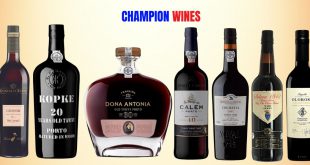
Founded in 1829, the oldest vintage at Bollinger is 1830. Following the tasting there were 11 bottles left.

The first vintage of R.D. is 1952, an exceptional wine.
On 21 June 2016, in the Grand Cru village of Aÿ, Champagne Bollinger delivered the ultimate tasting. Champagne Bollinger’s CEO Jerome Philippon (now CEO of the entire group) and their cellarmaster Gilles Descotes led the tasting. Here are my seven most memorable wines from that historic tasting.

The first vintage of VVF or Vieilles Vignes Francaise is 1969. The two parcels of vines – less than 0.5 ha – are ungrafted and not vulnerable to phylloxera. A pure pinot noir, when a vintage is declared, there are only 3,000 to 5,000 bottles of VVF produced.
Champagne Bollinger Vieilles Vignes Francaises 1969 ![]()
This is the first vintage of Vieilles Vignes Francaise, a pure pinot noir. What is even more remarkable is that the vines for producing VVF are ungrafted. The two parcels are walking distance from Champagne Bollinger. The decision to produce Vieilles Vignes Francaises was inspired by Cyril Ray, the late British journalist who made the suggestion to Lily Bollinger. It is one of the rarest and priciest wines in the world. Light gold. Truffle, mushroom and hint of citrus peel. Elegant and silky. The dosage is 4 g/l and the bottle disgorged in 2012. Only two bars of pressure in the wine. (A bottle of champagne usually has 6 bars of pressure. For every 10 years in the standard 750 ml bottle, about one bar of pressure is lost).
Champagne Bollinger R.D. 1952 ![]()
This is the first vintage of R.D. The initials stand for Recemment Degorge or Recently Disgorged. Bright gold in complexion, the nose is very fragrant. Who could have imagined, 64 years later, that there are still tropical notes of very ripe pineapples. Raisins and star anise too. This full-bodied wine was the most unusual Bollinger in the lineup. The dosage of R.D. 1952 also happened to be the highest, 13 g/l. This was actually not so much more than normal because the dosage of vintage Champagnes Bollinger produced then was about 10 g/l . Still, the added succulence and decidedly creamy texture were immediately discernible as soon as the wine was tasted. Jerome Philippon informed that this first R.D. was produced for the American market and released in 1967 (disgorged on 6 June of that year). He further revealed that the next 1953 R.D., the dosage was considerably lower because it was targeted at the British market instead.

Champagne Bollinger Ccellarmaster Gilles Descotes led the tasting on 21 June 2016.

Bollinger 1945 was the top wine in the historic tasting.
Champagne Bollinger 1945 ![]()
The German garrison in Paris finally surrendered on 25 August 1945. This exceptional wine was the perfect present to celebrate the end of World War II (1939 -1945) and liberation. Earlier that year, the winter was cold and the vintage turned out also to be the driest since 1833. Only 475 mm of rain fell in 1945 (when our group of journalists visited, Jerome Philippon informed that as of June 2016, there were already 600 mm for the first six months of the year). Gold. Very ripe but also very balanced. Not to mention very complex, including raisins, whiff of sandalwood, dried citrus peel and spice delivered in a texture that is ultra creamy. The dosage is 11 g/l and the bottle disgorged in 1969 (when Lily Bollinger was rebuilding her cellar). Deserves an extra star to make it a total of 6 stars.
Champagne Bollinger 1937 ![]()
Gold with hints of bronze. Whiff of truffle. Lighter and fresher than 1945. But not as intense or energetic, nor as long on the finish. Very elegant. The dosage is also 11 g/l. Disgorged in 1969.
Champagne Bollinger 1924 ![]()
Gold. Mushrooms – rather than truffles – on the nose. The fruit is still resonant and has a citrus peel finish. Light, fresh and wonderful harmony. Elegant.
Champagne Bollinger 1914 ![]()
World War I (1914 – 1918) had already started in July when grapes were being harvested. It was left to children, women and men who were not fighting the war to bring in the harvest. The nose is very unusual for this 102 year old. Incredibly, there is still a floral note. And spice and oils as those used in a spa treatment. Light but very fine. And still with a touch of fizz. Truly amazing.
Champagne Bollinger 1830 ![]()
This was the final wine tasted on Tuesday 21 June 2016. Vintage 1830 was just one year after Bollinger was founded on 6 February 1829 by Hennequin de Villermont, Paul Renaudin, and Jacques Bollinger (Villermont, the aristocrat, did not want his name mentioned on the brand). At that time, the house was known as Champagne Renaudin Bollinger. In 1854, Renaudin died without an heir but the labels only became solely Bollinger in the 1960s. There is still life and vitality in the 185-year old. Vintage 1830 was the coldest winter in France on record. Although the wine is still fresh, there are no more bubbles. Gold/bronze in colour. The fragile fruit includes mushroom, Chinese herbs, a light smokiness and a delicate minerality. Following the tasting, there are only 11 bottles of 1830 left in the Bollinger cellar.


